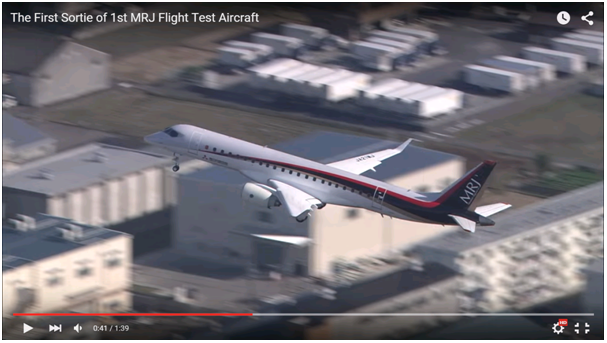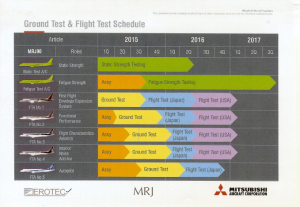Leeham News and Analysis
There's more to real news than a news release.
Leeham News and Analysis
- At long last, Boeing appears near certification and EIS for 777X
- Air India Flight 171 Preliminary Crash Report Is Unclear Regarding Pilot Actions
- Bjorn’s Corner: Air Transport’s route to 2050. Part 30.
- It’s official: MTU’s engine leader named CEO of Airbus Commercial from Jan. 1; future of Open Fan and A220-500 shifts to him
- Embraer E2: Where will the orders come from?
Bjorn’s Corner: MRJ90 first flight
13 November 2015, ©. Leeham Co: Mitsubishi flew their MRJ for the first time this week. I could have added “finally” because it is two years late compared to the original time plan. But who cares when the aircraft is finally ready to fly and everything goes well? (Well, the customers do, actually.)
It was a big moment for Japan, a nation with a sizable aeronautical industry. Japan has been a major partner to Boeing in their larger airplane programs over the 757/767 to the 777 and 787. For the Dreamliner, they even designed and made the hottest item, the high-tech Carbon Fibre Reinforced Plastic (CFRP) wing.
Despite having such a capable aeronautical industry, Japan has not built an own civil aircraft since it closed the production line for the YS-11 twin engined turboprop in 1973. Since then it has acted as sub-supplier and has worked on certain military programs like the Mitsubishi F-2 fighter, based on the Lockheed Martin F16. The Mitsubishi corporation flew the MRJ90 for the first time Wednesday from the Nagoya Airport in Japan (screenshot from video from Mitsubishi). Most of the flight testing will be done in Moses Lake (WA), USA, where four test airplanes will be based.
The Mitsubishi corporation flew the MRJ90 for the first time Wednesday from the Nagoya Airport in Japan (screenshot from video from Mitsubishi). Most of the flight testing will be done in Moses Lake (WA), USA, where four test airplanes will be based.
Moses Lake is blessed with open skies, little air traffic, a long runway and good weather. It has a long history of flight testing, serving as a test-base for Japan Air Lines 747 pilot training for decades. Boeing also uses Moses Lake for flight testing.
We analyzed the MRJ90 and its main competitor the Embraer E175 in a subscriber article the 25th of January. We will revisit the main characteristics and then comment on what could be seen from the first flight. Read more
Posted on November 13, 2015 by Bjorn Fehrm
Bjorn's Corner, Bombardier, CSeries, E-Jet, Embraer, Mitsubishi, Pratt & Whitney
737, 757, 767, 777, 787, A320, Bombardier, Embraer, Mitsubishi, MRJ-90
Embraer’s fundamental advantages
Subscription Required
Introduction
With the first Embraer E-Jet E2 under assembly, we take a look at the E1 and E2 programs in the run-up to ![]() roll-out of the E-190 E2 next year and projected Entry Into Service (EIS) in 2018.
roll-out of the E-190 E2 next year and projected Entry Into Service (EIS) in 2018.
Summary
- Broad customer base gives Embraer a major advantage against new competitors.
- More than 2,300 ERJs, E-Jets in service.
- More than 1,100 E-Jets in service.
- Broad product support a key advantage.
Posted on November 9, 2015 by Scott Hamilton
Bjorn’s Corner: Aircraft programs
30 October 2015, ©. Leeham Co: There has been dramatic news this week around Bombardier’s (BBD) CSeries program. I wrote a subscribers article about what to expect in terms of the cash flow problem that the BBD management has been wrestling with. The announcements yesterday and the following earnings call confirmed the financial modelling I did with our aircraft modelling tool.
Having watched experienced Wall Street analysts being hard pressed to understand what has happened with the CSeries, I thought I could use this week’s corner to explain the overall economical flow of an aircraft program like the CSeries (there will be details in a follow up subscriber article). I will also put it in context with how it affects a company like BBD and what one must think about when it comes to timing of such projects.
To give the timing aspect more colour, I will also compare with Embraer and their E-Jet E2 project and Boeing’s 787 program. The three programs are very different and they demonstrate in an illustrative way the challenges of making a new civil airliner and that one must adapt the project to the company’s position and its strength and weaknesses.
Posted on October 30, 2015 by Bjorn Fehrm
Mitsubishi opens Seattle Engineering Center ahead of MRJ90 first flight
August 3, 2015, © Leeham Co.: Mitsubishi Aircraft Corp. today opened its Seattle Engineering Center jointly with local company AeroTEC in advance of the first flight of the MRJ90 in September or October. During the second quarter of next year, four of five MRJ Flight Test Vehicles will be domiciled in Moses Lake in Central Washington for the bulk of the flight testing over the following year. Entry into service is planned for 2Q2017 with launch customer All Nippon Airways.
The engineering center represents the first in Washington State for an aircraft OEM other than Boeing. Mitsubishi will assign 50 engineers from Japan to the new SEC, in South Seattle a short distance from Boeing Field. One hundred engineers will be hired locally.
AeroTEC and Mitsubishi began discussing working together only last January, said president Lee Human, who added that the seven months from January to the opening of the SEC today was remarkable for the speed in which negotiations, contracts, permits and hiring was achieved.
Posted on August 3, 2015 by Scott Hamilton
Pontifications: Mitsubishi nears first flight for MRJ-90
Aug. 3, 2015, © Leeham Co. Mitsubishi is just a few months away from beginning flight testing on the first commercial airplane designed and built in

Japan’s first commercial airliner after World War II was the YS-11 turbo-prop. Photo via Google images.
Japan since the NAMC YS-11 in the 1960s.
The 60 passenger turbo prop had its first flight in 1962 and entered service three years later with ANA. Only 182 were built, and it had a surprisingly wide customer base in the primary and secondary markets. Google images has a nice montage of the operators, which spanned the globe.
Japan’s first commercial airliner since the YS-11 is the MRJ-90 by Mitsubishi. Photo via Google images.
The Mitsubishi MRJ 90 as yet doesn’t have wide acceptance. There are about 200 firm orders and about an equal number of options, but the customer base is thin: 100 of the orders and 100 of the options come from the USA’s SkyWest Airlines and 50+50 are from the USA’s Trans States Airlines. All Nippon Airlines orders 15 and Japan Air Lines ordered 32. Air Mandalay ordered six and the new Eastern Airlines, a start-up carrier, ordered 20.
And that’s it.
The MRJ is a 2×2 passenger cabin configuration with comfortable 18-inch wide seats. The passenger experience should be similar to the Embraer E-Jet that’s been in service since 2004 and better than the Bombardier CRJ Series, which is a cramped cabin.
The MRJ is two years late. The first flight is now scheduled for October and entry-into-service in 2017. But with the vast majority of the orders coming from US regional airlines that contract for US majors, there’s just one problem: the MRJ-90 exceeds the allowable airplane weight in the pilot contracts permitting regional flying on behalf of the majors. This is under what’s called the Scope Clause.
Posted on August 3, 2015 by Scott Hamilton
Boeing, Bombardier, E-Jet, Embraer, Mitsubishi, Pontifications
747, 747-8, 787, All Nippon Airways, Boeing, Bombardier, CRJ, CRJ-1000, CRJ-900, E-Jet, E-Jet 175, E-Jet 175 E2, E-Jet E2, Embraer, ExIm Bank, GE, Japan Air Lines, Jim McNerney, Mitsubishi, MRJ, MRJ-70, MRJ-90, SkyWest Airlines, Trans States Airlines
Embraer ramps up smaller airplane messaging
May 28, 2015, c. Leeham Co. Embraer is ramping up is messaging that the E-Jet family provides a better Return on Capital Employed in many circumstance than the larger Airbus and Boeing single-aisle family.
In a new push to be unveiled at the Paris Air Show in a little over two weeks, Embraer will describe its “New Metrics for Success” to an international audience in an open forum.
EMB has been showing airlines and lessors the concept for some time, and we received a briefing on the essential elements when we visited EMB last October at is home base in San Jose, Brazil.
New Metrics for Success takes airlines away from the traditional metric of economics, the Cost per Available Seat mile, and focuses trip costs and the higher quality revenue obtained by limiting the number of low-yield seats on a flight that must be offered to fill larger airplanes. Read more
Posted on May 28, 2015 by Scott Hamilton





